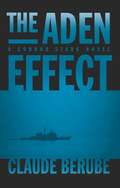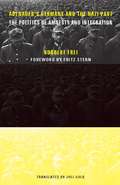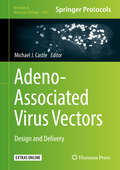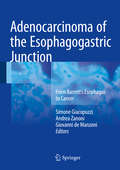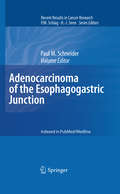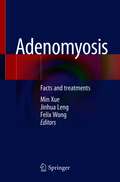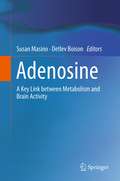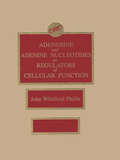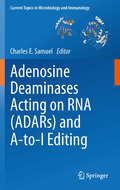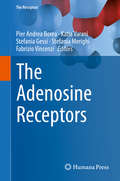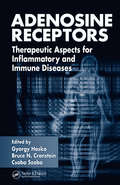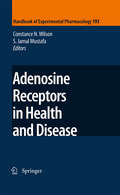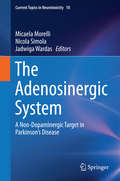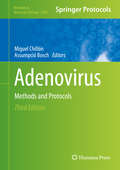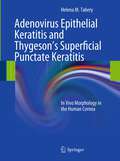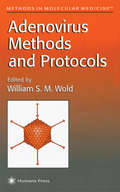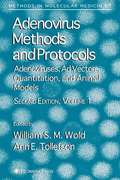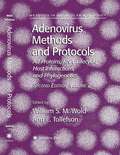- Table View
- List View
Adem's Cross
by Alice MeadFourteen-year old Adem, an Albanian boy, lives in Serb-occupied Kosovo. Adem hates existing in a constant state of terror. Every week, friends and family are beaten, teargassed, and killed. The Albanians are helpless, and even passive resistance can get you killed--as is Adem's sister Fatmira, gunned down while reading a protest poem. Now Adem must decide how to survive this never-ending nightmare--with or without his family.
Aden and the Indian Ocean Trade
by Roxani Eleni MargaritiPositioned at the crossroads of the maritime routes linking the Indian Ocean and the Mediterranean Sea, the Yemeni port of Aden grew to be one of the medieval world's greatest commercial hubs. Approaching Aden's history between the eleventh and thirteenth centuries through the prism of overseas trade and commercial culture, Roxani Eleni Margariti examines the ways in which physical space and urban institutions developed to serve and harness the commercial potential presented by the city's strategic location.Utilizing historical and archaeological methods, Margariti draws together a rich variety of sources far beyond the normative and relatively accessible legal rulings issued by Islamic courts of the time. She explores environmental, material, and textual data, including merchants' testimonies from the medieval documentary repository known as the Cairo Geniza. Her analysis brings the port city to life, detailing its fortifications, water supply, harbor, customs house, marketplaces, and ship-building facilities. She also provides a broader picture of the history of the city and the ways merchants and administrators regulated and fostered trade. Margariti ultimately demonstrates how port cities, as nodes of exchange, communication, and interconnectedness, are crucial in Indian Ocean and Middle Eastern history as well as Islamic and Jewish history.
The Aden Effect
by Claude G. BerubeAlpha team was gone, dead to a man. A few crewmen from Bravo team had been blown overboard. Stark reentered the pilothouse and checked the radio hoping to get out one last mayday, but the radio, like the crew, was dead....Connor Stark was a pariah, a man without a country, a former naval officer whose career came to an unceremonious end after a court-martial resulted in a dishonorable discharge. At home and at peace in Scotland, he was determined to leave his past behind until murder, politics, and Middle East instability prompted his unexpected recall to active duty. . Set against a background of modern piracy in the Gulf of Aden, the story begins as the new American ambassador to Yemen, C. J. Sumner, is assigned to negotiate access to the oil fields off the island of Socotra and enlists Stark's help countering pirates who are capturing ships at will off the Horn of Africa. Meeting with resistance to her diplomatic overtures, Sumner recruits Stark, who has become a mercenary after being dishonorably discharged, as her defense attaché, because he knows the region. When Stark sets up a meeting with the owner of a Yemeni shipping company and the ruling
The Aden Vanner Novels: Sleep No More, Sorted, and Close Quarters (The Aden Vanner Novels #3)
by Jeff GulvinThe complete police-procedural trilogy featuring maverick London Inspector Aden Vanner: Sleep No More, Sorted, and Close Quarters. Sleep No More: London&’s Detective Chief Inspector Aden Vanner, former member of the Irish Army, has never tracked a serial killer as elusive as the Watchman. The victims are all ordinary citizens in need of some twisted retribution, shot execution-style. But when Vanner is shut out of the case by his superintendent, it could cost him more than his career, because Vanner has suddenly become the prime suspect. Sorted: Aden Vanner, demoted from the rank of London&’s Detective Chief Inspector, is beaten outside a pub by unknown assailants. Vanner knows the difference between a garden-variety robbery and something else. This felt like payback. Considering how many people Vanner has crossed, it could be anyone. Now it&’s Vanner&’s turn to get even—and where better than as new Detective Inspector of the Drug Squad. Close Quarters: Aden Vanner is investigating drug dealers in the Harlesden district of London when the shooting death of a suburban wife captures his attention. As Vanner digs into the case, he begins to make connections between her murder and the Harlesden gang, between her husband and the IRA, and between himself and a vengeful old acquaintance. When all the pieces collide, even Vanner isn&’t prepared for the explosion. Informed by his research with the Metropolitan Police Department, Jeff Gulvin&’s thrilling trilogy brings readers into criminal London with frightening authenticity. &“Gulvin keeps your nose glued to the page.&” —The Literary Review
Adenauer's Foreign Office: West German Diplomacy in the Shadow of the Third Reich
by Thomas MaulucciThe creation of the Foreign Office under Adenauer tells us much about the possibilities and limits of professional diplomacy in the mid-twentieth century. It also demonstrates three themes central to the early history of the Federal Republic: the integration of the new state into the international community, the cooptation of German elites and traditions by the new political system, and the creation of government in a state under foreign occupation. In this important study, Thomas Maulucci argues that, despite an improvised start and a considerable continuity of practice and personnel with pre-1945 Germany, the changed international anddomestic situation proved decisive in creating a ministry that could help to implement new directions in German foreign policy. In addition, Maulucci explores the interactions between international, political, and social history, contributing to a literature that bridges the gap between the pre- and post-World War Two eras that characterized previous writing on German history. Based on extensive research in German, American, British, and French archives, Adenauer's Foreign Office is the only English-language book of its kind. The troubling question of personnel continuity in the German diplomatic service is of considerable importance today, especially because of the Foreign Office's previous attempts to portray its past in the best possible light. Of interest to scholars and students of German history and politics as well as non-specialists, this book provides new insights into post-war diplomacy, the sociology of German elites, and the problems involved in creating a new government after losing a major war.
Adenauer's Germany and the Nazi Past: The Politics of Amnesty and Integration
by Norbert FreiOf all the aspects of recovery in postwar Germany perhaps none was as critical or as complicated as the matter of dealing with Nazi criminals, and, more broadly, with the Nazi past. While on the international stage German officials spoke with contrition of their nation's burden of guilt, at home questions of responsibility and retribution were not so clear. In this masterful examination of Germany under Adenauer, Norbert Frei shows that, beginning in 1949, the West German government dramatically reversed the denazification policies of the immediate postwar period and initiated a new "Vergangenheitspolitik," or "policy for the past," which has had enormous consequences reaching into the present. Adenauer's Germany and the Nazi Past chronicles how amnesty laws for Nazi officials were passed unanimously and civil servants who had been dismissed in 1945 were reinstated liberally—and how a massive popular outcry led to the release of war criminals who had been condemned by the Allies. These measures and movements represented more than just the rehabilitation of particular individuals. Frei argues that the amnesty process delegitimized the previous political expurgation administered by the Allies and, on a deeper level, served to satisfy the collective psychic needs of a society longing for a clean break with the unparalleled political and moral catastrophe it had undergone in the 1940s. Thus the era of Adenauer devolved into a scandal-ridden period of reintegration at any cost. Frei's work brilliantly and chillingly explores how the collective will of the German people, expressed through mass allegiance to new consensus-oriented democratic parties, cast off responsibility for the horrors of the war and Holocaust, effectively silencing engagement with the enormities of the Nazi past.
Adeno-Associated Virus: Methods and Protocols (Methods in Molecular Biology #807)
by Richard O. Snyder Philippe MoullierToday, progress in rAAV-mediated gene transfer is so robust that long-term, efficient, and regulatable transgene expression is reproducibly achieved in large animal models. The complexity of gene transfer agents in the context of their clinical use requires investigators from a wide variety of backgrounds to have an understanding -- or at least an appreciation of -- the regulatory environment and constraints that affect vector design, manufacturing, pre-clinical testing, and clinical use, with an emphasis on patient protection. In Adeno-Associated Virus: Methods and Protocols, experts from the United States and Europe have contributed current knowledge of this multi-dimensional field relating to the biology of AAV, rAAV vector design, vector manufacturing and product testing, performance of rAAV vectors in major organs, rAAV-related immunological issues, design of animal and clinical studies, and clinical experience. Written in the successful Methods in Molecular BiologyTM series format, chapters include introductions to their respective topics, lists of the necessary materials and reagents, step-by-step, readily reproducible protocols, and notes on troubleshooting and avoiding known pitfalls. Authoritative and accessible, Adeno-Associated Virus: Methods and Protocols provides a complete and comprehensive understanding of this multi-disciplinary and rapidly progressing field.
Adeno-Associated Virus Vectors: Design And Delivery (Methods In Molecular Biology Series #1950)
by Michael J. CastleThis volume provides a complete and timely guide to the use of adeno-associated virus (AAV) vectors for genetic manipulation of mammalian tissues. Beginning with methods for the design and characterization of AAV vectors, the book continues with protocols for AAV delivery to various components of the central nervous system, to a number of sensory systems, and to a broad range of other tissues. Novel techniques such as ultrasound-targeted delivery to the brain, subpial delivery to the spinal cord, and subILM delivery to the retina are accompanied by chapters that provide an overview and comparison of current methods for AAV delivery to tissues such as brain, heart, liver, and lung. Written for the highly successful Methods in Molecular Biology series, chapters include introductions to their respective topics, lists of the necessary materials and reagents, readily reproducible step-by-step laboratory protocols, and tips for troubleshooting and avoiding known pitfalls. <P><P> Authoritative and comprehensive, Adeno-Associated Virus Vectors: Design and Delivery aims to enhance the utility of AAV vectors for targeted gene transfer to living animals and continue the ongoing development of novel AAV-based gene therapies for human disease.
Adenocarcinoma of the Esophagogastric Junction: From Barrett's Esophagus to Cancer
by Simone Giacopuzzi Andrea Zanoni Giovanni ManzoniThis book offers up-to-date and comprehensive coverage of the diagnosis and therapy of adenocarcinoma of the esophagogastric junction (EGJ). As is appropriate in the era of multidisciplinary and multimodal treatment, the contributions of all the various specialists involved cooperatively in the treatment of EGJ cancer are thoroughly described. Detailed attention is also paid to the significance of preneoplastic lesions, such as Barrett esophagus. The final part of the book represents a surgical atlas documenting the techniques used in the EGJ region, with superb color images and stepwise description of procedures. Against the background of the rapidly increasing incidence in EGJ cancer, especially evident in Western countries, there is a need for greater uniformity in management strategies, which currently vary significantly across the world. This book provides appropriate guidance that will assist all practitioners involved in the diagnosis and treatment of EGJ cancers, including surgeons, oncologists, and radiotherapists.
Adenocarcinoma of the Esophagogastric Junction: Adenocarcinoma Of The Esophagogastric Junction (Recent Results in Cancer Research #182)
by Paul M. SchneiderAmong malignant tumors, adenocarcinomas of the esophagogastric junction show the highest increase in incidence over the past three decades in Western industrialized countries. This special volume, with contributions from experts in the field, covers all aspects of the disease. Etiology, pathogenesis, classification, and clinical staging are discussed, and there is special emphasis on state of the art treatment techniques. The latter range from endoscopic mucosal resections or limited surgical resections for early cancers to multimodality treatment options for locally advanced tumors. Emerging quality issues in surgical management are addressed. Detailed attention is also paid to other important recent developments, including molecular response prediction, early metabolic response evaluation by PET and PET-CT, the diagnosis of micrometastases, and the use of sentinel node technology. This volume will be of interest to all clinicians concerned with the diagnosis and management of this malignancy.
Adenomyosis: Facts and treatments
by Min Xue Jinhua Leng Felix WongThis book aims to provide updated facts and treatments for practicing gynecologists and postgraduate doctors to enhance their understanding of pathogenesis, pathology, symptoms and diagnostic imaging technology of adenomyosis, such as to select appropriate treatments, to improve the symptoms, fertility and the quality of life of women with adenomyosis. This book also particularly introduces the new treatment for adenomyosis using the non-invasive High Intensity Focused Ultrasound ablation treatment. Hopefully, it will provide a better understanding of its operation, effectiveness, and pregnancy outcome, to formulate a more successful treatment strategy for this disease.
Adenosine: A Key Link between Metabolism and Brain Activity
by Susan Masino Detlev BoisonHomeostasis of key metabolites and metabolic health affects all bodily systems. Not surprisingly, altered metabolic function is associated with a wide spectrum of dysfunctions in the central nervous system - including developmental disorders, acute nervous system injury, and neurodegenerative disorders. Accordingly, metabolism-based therapies offer significant promise as new category of treatment options designed to limit, delay or reverse the disease process by reconstructing homeostatic functions. Increasingly it is appreciated that restoring metabolic health could promote normal nervous system activity, and improve behavior and cognition. Adenosine: A Key Link Between Metabolism and Central Nervous System Activity focusses on diverse aspects of adenosine, an evolutionarily conserved homeostatic bioenergetic regulator in the central nervous system. Because of its interrelationship with ATP (adenosine triphosphate), adenosine is integral to cell metabolism. At the same time, adenosine influences neuronal activity directly via receptors, and is involved in biochemical processes related to gene expression. Thus, adenosine is uniquely placed as a reciprocal and rapid link between changes in metabolism and changes in neuronal activity, and, on a longer time scale, to changes in gene expression and long term changes in cell function. Leaders in the field feature basic research on adenosine at the cellular level in the central nervous system, and relate these findings to its recognized potential in diverse acute and chronic disorders. This comprehensive overview of adenosine also highlights emerging adenosine-based treatments and associated opportunities for central nervous system disorders.
Adenosine and Adenine Nucleotides As Regulators of Cellular Function
by John W. PhillisThis book provides valuable information for investigators interested in the signaling and regulatory functions of adenosine and the adenine nucleotides. Topics covered in this comprehensive volume include the historical development of research on adenosine and adenosine triphosphate; various aspects of the formation, metabolism, release, transport, and receptors for endogenous adenosine and the adenosine triphosphate; functions of purines at the cellular level; the role of adenosine in the regulation of flow in different vascular beds; and angiogenesis. The book also addresses the purinergic regulation of the cardiac, renal, gastro-intestinal, and central nervous system, as well as potential therapeutic avenues for purine use. The book will be valuable to physiologists, pharmacologists, and other basic and clinical scientists interested in updating their knowledge of the expanding biological roles of these substances.
Adenosine Deaminases Acting on RNA (Current Topics in Microbiology and Immunology #353)
by Charles E. Samuel"The objective of this CTMI volume is to provide readers with a foundation for understanding what ADARs are and how they act to affect gene expression and function. It is becoming increasingly apparent that ADARs may possess roles not only as enzymes that deaminate adenosine to produce inosine in RNA substrates with double-stranded character, but also as proteins independent of their catalytic property. Because A-to-I editing may affect base-pairing and RNA structure, processes including translation, splicing, RNA replication, and miR and siRNA silencing may be affected. Future studies of ADARs no doubt will provide us with additional surprises and new insights into the modulation of biological processes by the ADAR family of proteins."
The Adenosine Receptors (The Receptors #34)
by Pier Andrea Borea Katia Varani Stefania Gessi Stefania Merighi Fabrizio VincenziThis book traces the history of adenosine receptor research from molecular biology to medicinal chemistry to behavior, including their implications in disease and potential strategies as therapeutic targets. It provides the reader with a comprehensive overview of the adenosine receptors that includes information on all subtypes - A1, A2A, A2B and A3. Aspects addressed include the most up to date information on their functional distribution in the nervous and peripheral systems, behavioral roles in inflammation, cancer, pain and neurological diseases such as Huntington’s disease, Epilepsy, Parkinson’s disease and Alzheimer’s disease.
Adenosine Receptors: Therapeutic Aspects for Inflammatory and Immune Diseases
by György Haskó Bruce N. Cronstein Csaba SzabóAfter a century of research, several lines of evidence now indicate that the ability of adenosine to directly control inflammatory cells has a major impact on the functions of the inflammatory and immune systems. Consequently, many promising therapeutic approaches are beginning to emerge that focus on the modulation of adenosine, including the deve
Adenosine Receptors in Health and Disease (Handbook of Experimental Pharmacology #193)
by Constance N. Wilson S. Jamal MustafaSince their discovery approximately 25 years ago, adenosine receptors have now emerged as important novel molecular targets in disease and drug discovery. These proteins play important roles in the entire spectrum of disease from inflammation to immune suppression. Because of their expression on a number of different cell types and in a number of different organ systems they play important roles in specific diseases, including asthma, rheumatoid arthritis, Parkinson's disease, multiple sclerosis, Alzheimer's disease, heart disease, stroke, cancer, sepsis, and obesity. As a result of intense investigations into understanding the molecular structures and pharmacology of these proteins, new molecules have been synthesized that have high specificity for these proteins and are now entering clinical trials. These molecules will define the next new classes of drugs for a number of diseases with unmet medical needs.
The Adenosinergic System
by Micaela Morelli Nicola Simola Jadwiga WardasAdenosine A2A receptor antagonists have shown great promise in the treatment of Parkinson's Disease and alleviation of symptoms. This book addresses various aspects of this class of drugs from their chemical development to their clinical use. Among the many insightful chapters contained in this book, there are three unique reviews that have not previously been published in any format: (1) a history of istradefylline, the first A2A antagonist approved for treatment of Parkinson's Disease, (2) an overview of neuroimaging studies in human death and disease and (3) a study of urate as a possible biomarker and neuroprotectant.
Adenovirus: Methods and Protocols (Methods in Molecular Biology #1089)
by Miguel Chillón Assumpció BoschReflecting the development of powerful new tools and high-throughput methods to analyze adenoviral particles and their interactions with host cells, the third edition of "Adenovirus Methods and Protocols" calls upon experts in the field to convey advances in molecular biology, genomics and proteomics, imaging, and bioinformatics. Beginning with cryo-electron microscopy, atomic force microscopy, and mass spectrometry for a high resolution image and characterization of the virion, this detailed book then continues with capsid modifications and viral-like particles as promising alternatives to classical adenovirus vectors, and the study of adenovirus in host interactions in vitro at the cellular level as well as in vivo in animal models. Finally, the volume concludes with an extensive update of the most efficient protocols to generate, amplify, and/or purify, at small and large scale, standard human Ad5 as well as non-human, chimeric, and helper-dependent adenovirus vectors. Written in the greatly successful "Methods in Molecular Biology" series format, chapters include introductions to their respective topics, lists of the necessary materials and reagents, step-by-step, readily reproducible laboratory protocols, and tips on troubleshooting and avoiding known pitfalls. Comprehensive and cutting-edge, "Adenovirus Methods and Protocols, Third Edition" serves as an ideal guide for scientists continuing to research this highly valuable viral tool.
Adenovirus Epithelial Keratitis and Thygeson's Superficial Punctate Keratitis: In Vivo Morphology in the Human Cornea
by Helena M. TaberyDespite differences in frequency, causation, and infectivity, adenovirus epithelial keratitis and Thygeson's superficial punctate keratitis (TSPK) are often confused in clinical practice owing to the similarity between adenovirus epithelial infiltrates and 'coarse' epithelial TSPK lesions. This book presents the morphological features, dynamics, and sequelae of adenovirus and Thygeson's keratitides captured at high magnification in the living human cornea. It thereby fills the existing void between conventional photographs and slit-lamp observations. Case reports demonstrate the importance of patient history in differential diagnosis, illustrate the need for familiarity with early manifestations of adenovirus infections, and assist in the diagnosis of rare variants of TSPK. Furthermore, the detailed observations on the natural course of the diseases ensure that the book will serve not only as a diagnostic tool but also as a reference when evaluating the effects of potential new treatments.
Adenovirus Methods and Protocols: Volume 2: Ad Proteins And Rna, Lifecycle And Host Interactions, And Phyologenetics (Methods in Molecular Medicine #21)
by William S. WoldIn Adenovirus Methods and Protocols, William S.M. Wold has organized a collection of readily reproducible methods for conducting research with adenoviruses, the premier and most widely used model in cell and molecular biology. The methods range from how to grow and titer adenoviruses and how to construct specific alterations in the adenovirus genome, to how to measure apoptosis induced by cells of the immune system, cytokines, and intrinsic apoptosis effectors. In addition, there are methods to study transcription and splicing with in vitro systems and for the adenovirus-mediated transformation of cells to a malignant state. Each method is written by a prominent investigator well-versed in the technique and includes a brief background discussion, as well as tried and true step-by-step instructions.<P><P> Adenovirus Methods and Protocols will be useful to both entry-level and senior scientists seeking to enter the adenovirus field, to researchers from other areas wishing to construct adenovirus vectors for their own research, and to adenovirologists wanting to enter new sectors of research. Its cutting-edge techniques are certain to make it today's reference of choice, one from which even expert researchers will learn many productive and time-saving techniques.
Adenovirus Methods and Protocols, Second Edition, Volume 1: Volume 1: Adenoviruses, Ad Vectors, Quantitation, and Animal Models (Methods in Molecular Medicine #130)
by William S. Wold Ann E. TollefsonAdenovirus Methods and Protocols, Second Edition, now in two volumes, is an essential resource for adenovirus (Ad) researchers beginning in the field, and an inspirational starting point for researchers looking to branch into new areas of Ad study. In addition to updating and expanding the first edition, the authors have added new chapters that address innovative areas of emphasis in Ad research, including Ad vector construction and use, real-time PCR, use of new animal models, and methods for quantification of Ad virus or virus expression/interactions. Each of the protocols presented in these volumes is written by trendsetting researchers.
Adenovirus Methods and Protocols, Second Edition, Volume 2: Volume 2: Ad Proteins and RNA, Lifecycle and Host Interactions, and Phyologenetics (Methods in Molecular Medicine #131)
by William S. Wold Ann E. TollefsonAdenovirus Methods and Protocols, Second Edition, now in two volumes, is an essential resource for adenovirus (Ad) researchers beginning in the field, and an inspirational starting point for researchers looking to branch into new areas of Ad study. In addition to updating and expanding the first edition, the authors have added new chapters that address innovative areas of emphasis in Ad research, including Ad vector construction and use, real-time PCR, use of new animal models, and methods for quantification of Ad virus or virus expression/interactions. Each of the protocols presented in these volumes is written by trendsetting researchers.
Adeo Health Science: Turning a Product into a Brand
by Elizabeth A. Keenan Jill AveryFor decades, American parents were warned to avoid introducing potential allergens to their babies prior to their first birthday. But two influential clinical studies caused the medical establishment to radically reverse their position. Parents were now warned that delaying the introduction of these types of foods increased a baby's risk of food allergies. Adeo Health Science was ready, with patents filed for a baby food that made it simple for parents to introduce allergens. Now, the new company had to turn its product into a brand and map its go-to-market strategy, including creating a compelling value proposition, choosing a path to market that was either direct-to-consumer, through grocery retailers, or via the physician channel, and planning its marketing communications and sales strategy. As a new startup with constrained resources, the company knew its marketing decisions would make or break the new product.


